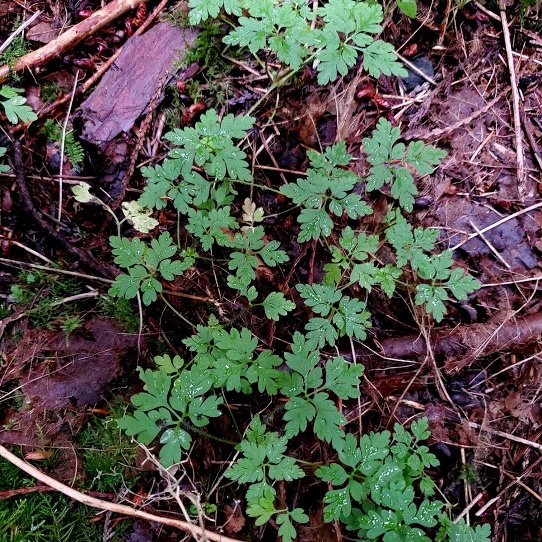I’m patrolling edges this month, removing invasive annuals and biennials. My favorite tool for this work is a narrow hand trowel which can “pry and pop” some types of weeds without too much soil disruption. I collect them in a five-gallon bucket as I go, because they can re-root if left lying on the ground. For now, I’ll risk disposing of them on a compost heap. After they flower, they are best bagged and trashed or added to a yard waste bin, because otherwise they can go to seed even while sitting on compost heaps with roots exposed to the air.
I talk about three of my current targets below:
Herb Robert (Geranium robertianum)
My top priority is Herb Robert, a.k.a. Stinky Bob, Death-Come-Quickly, and numerous other amusing common names. I’m especially looking for those plants that have wintered over and will flower early. I remove them one-at-a-time by first pushing the plants to the side to expose the “buttons” where the stems join. Then, getting a good grip on the buttons, I gently “wiggle and pull” to get as many of the tiny roots as I can. I’m finding that persistence pays off for Herb Robert plants, because I’m seeing less and less of them in areas I’ve weeded consistently for several years in a row.
Creeping Buttercup (Ranunculus repens)
In their favored wet areas, the ground is still moist enough this month to remove Creeping Buttercup plants. Even at a creep, they spread amazingly fast, so now I’m faced with several established colonies. I find that I basically have to dig them out individually. I try to preserve the topsoil by shaking it off the roots, but their removal significantly disturbs the ground. To mitigate this impact, I’ll remove them a little each year by containing the colonies inside weed breaks. Then I’ll gradually tighten the perimeters as native plants fill in behind.
Cleavers (Galium aparine)
Update: May 2024. I’m no longer removing cleavers except in my best two small beds of native flowers. What I said below still applies, “pulling them is mostly cosmetic.” They may even be native.
Cleavers have quite a few amusing common names like “whippysticks” and “sticky willy,” and a sense of humor helps temper the futility of trying to eradicate them. I think pulling them is mostly cosmetic — I don’t like the way they overwhelm the other low-growing plants at the edge of the forest and then turn brown.
My strategy for Cleavers is different than the other weeds– I simply pull off the above-ground parts of the plants incidental to working the edges of the forest. I know that the weak stems will break before any roots come out, and the plants will soon grow back. The trowel doesn’t help since “pry and pop” doesn’t work for Cleavers, and it’s not worth disturbing the ground by digging them out. The only thing about controlling Cleavers that gives me any hope is the fact that they are annuals, and I can keep them down in a few prime areas by pulling them every couple weeks before they have time to flower.
